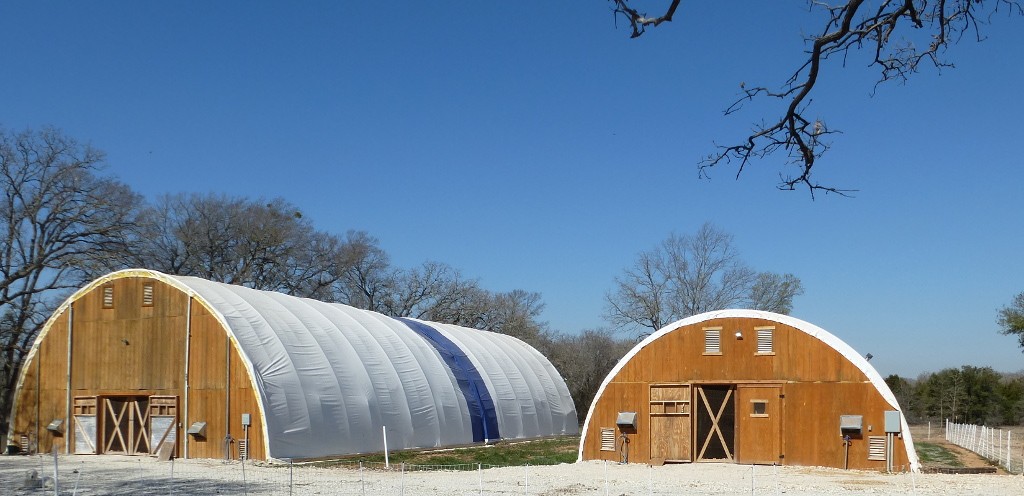
Housing for part of the Noah’s Ark Project
Background: As we’ve mentioned previously, in May of 2015, Murray McMurray Hatchery brought a truckload of 3,700 newly-hatched chicks to Joe Claborn’s farm in Texas for safekeeping as Avian Influenza was spreading in the U.S. and in Iowa. The project has informally come to be known as the “Noah’s Ark Project.” This interview with Joe Claborn, gives more information on the current state of this project.
Q: Can you give us an update on the Noah’s Ark Project?
We’re seven months into caring for these chickens now, and all of the breeds are laying. From fourteen of the breeds we’re collecting eggs daily, which we then ship to McMurray for hatching. We keep these fourteen breeds in our barn on deep bedding. The rest of the birds we keep in our two hoop houses.
Q: Have you’ve learned anything unexpected from this project?
Well, probably the most unexpected thing I’ve learned is just the experience of raising so many different breeds and learning their different characteristics. I’ve never raised so many breeds before, and being able to care for them side-by-side, you really get to see the differences.
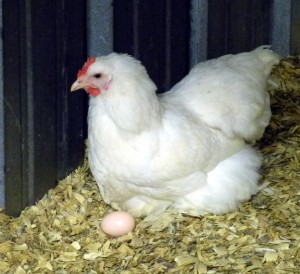
White Cochin
For example, White Cochins. They will go broody with no eggs under them. They are so broody — it’s amazing! Every day I go in to look for eggs, and there’ll be three to five broody hens, sitting there with no eggs under them. I’ll move them to look for eggs, and it turns out that they’re just “brooding” the dirt, like they think it’s going to hatch.
I’m thinking of taking eggs from some of my other breeds and putting them under the White Cochins just as an experiment to see what will happen because I think they’ll probably hatch them. And people say that a hen raised by a broody hen is more likely, herself, to go broody.
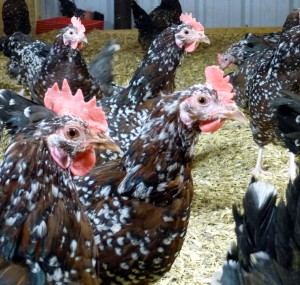
Speckled Sussex
Another breed that really interests me is the Speckled Sussex. I’ve really grown to like these. Their natural speckling makes a good camoflauge, which I think is going to help make this a great homesteading bird, and they’re prolific egg layers. The downside is that they eat voraciously — they eat probably twice as much as any similarly-sized bird. (They get four scoops of feed a day instead of two — all my other pens get two.)
And then some of the breeds that I would have just thought of as “eye-candy,” like the Golden Polish …. It turns out that the Golden Polish are very good white egg layers. They’re still kind of unusual to raise because when you walk toward them, a lot of times they can’t see you coming — the feathers block their vision, particularly of things above and behind them. And when they realize that you’re standing right beside them, they get a little startled. So that makes them kind of interesting.
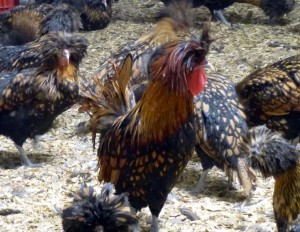
Golden Polish
Another breed that surprised me is Buff Cochins. They lay like crazy. I’m probably getting more eggs out of their pen than any of the others. And the Buff Cochin hens … there are several that want to go broody. But they’re not like the White Cochins — when I move the Buff Cochins off their nest, then they stop being broody, so I don’t know that these would actually stick it out long enough to hatch out eggs.
Q: You mentioned earlier about using deep bedding. Can you explain that more?
About two months ago, we switched from cleaning the pens about once a week to using a deep litter (or deep bedding) system, and this has really helped. It cuts down on the work, and it also provides a very clean, healthy environment for the birds.
Down at the bottom of the bedding, we’ve now got several inches of pretty well-composted material, and the bedding on top is less composted. In the mornings, when I feed the birds, I go through and sprinkle some feed across the top of the bedding. This accomplishes two things. First, the roosters think that it’s their job to show the hens where the food is, and so they get all excited and start clucking and scratching. And all that scratching is mixing the litter up — aerating it for me. We still go in about once a week and aereate it by hand, too — we just take a pitch fork and fluff the bedding up a bit. This gives us a chance to make sure there are no undetected water leaks, and it adds more air to the bedding, which helps it compost. Basically, the deep litter is just a big compost pile, so it needs some aeration to stay active.
Q: What are the plans for this project?
For the next couple of months, we’re going to just keep maintaining the status quo. We’re here to supply eggs to McMurray hatchery, and we’re here to supply breeders if they run into any problems up there.
Longer term, I think we’ll be doing this for another year. Earlier, it looked like we might not have a bird flu season this year, but with that recent break in Indiana, we see that it just takes one break and 500,000 birds are gone. It doesn’t take but one break close by you, and you could be in danger. So, I think we’re going to continue for one more year down here, then we’ll re-evaluate about this time next year and decide what to do from there.

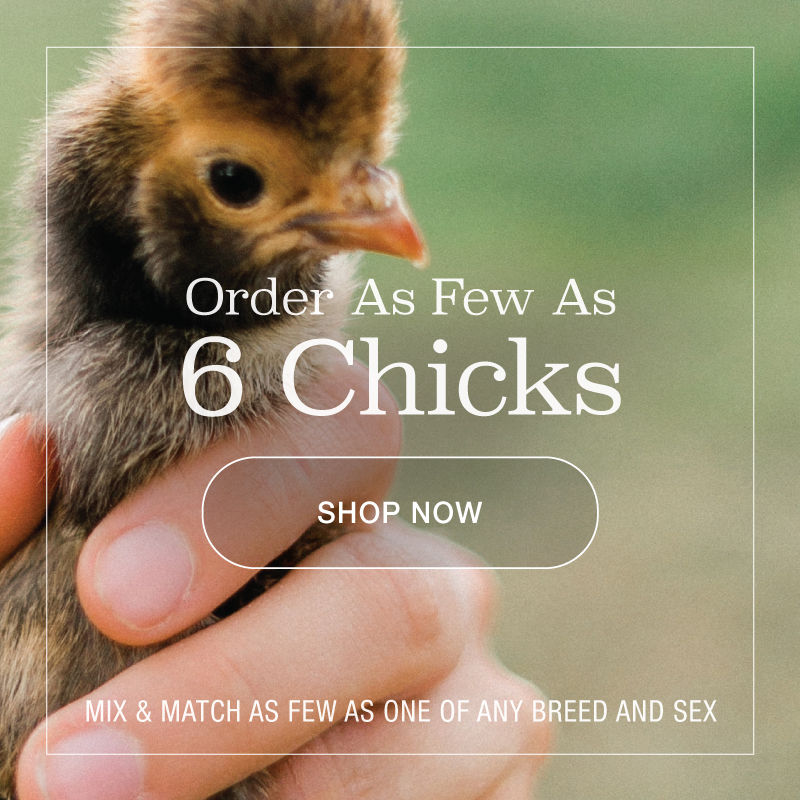

I really liked the info on specific breeds–added bonus to the Noah Project. It’s helpful to know more than the standard catalog information. I hope you continue to inform us with your new insights on different breeds.
Good useful information. Do you think if I put a white Cochin in with my SS hens she would brood their eggs? Would that be a good plan? I use a deep litter method – mostly because I am too old to be mucking out a coop – and I toss scratch in, just as you do. I have had no problems with this system, and I recommend it. Plus, it keeps the birds busy and unbored.
Wow what interesting work. We all need you folks. BRAVO! Liz.
This is an amazing feat!
I have been expanding my flock diversity over the years and have come to appreciate the different characteristics of each breed.
Thank you for caring for these birds. Hopefully in the future, some of their progeny will end up here in New Hampshire!
I am still curious about the deep bedding technique. Do you empty everything out at some point or does the continuous churning decompose the manure in a timely manner?
I have one Buff Cochin hen who has gone broody and the temperature is 12 degrees here in Byhalia, MS. That’s just a few miles south of Memphis, TN. She was in my order from Murray , but not ordered by me. That’s why I only have 1. There she is all fluffed up setting on her shavings. She sets with an attitude as in, “THIS is where I am supposed to be so BACK OFF!” After the third day of this, I removed her from her nest of shavings (no eggs!) under great protest. I carried her out to the rest of the flock and she hawked around all fluffed up. I kept checking on her throughout the day thinking that I would have to continue with several ‘removals’. To my surprise, she stayed out the whole day scratching, eating and dusting. I expect that she will be ‘back on the nest’ tomorrow and I will remove her each time. But, I think you are right about these birds as they are sort of ‘dizzy’. As tenacious as she is now, I don’t believe she would set long enough to hatch. Last year and at only 7 mos of age, she became seriously broody. I tried her on some fertile eggs and she apparently got bored as she decided that this was not the life for her as she quit setting 8 days before the anticipated hatch! But she’s beautiful to look at! Good Luck with your project. Sharon Buske
This is awesome! I read the original article and I’m happy to have seen this update. Thanks for the information and good luck with all of your hard work.
Enjoyed the article and fascinated by this project. Loved his interest in the Cochin’s as that’s my favorite breed. They definitely good broody a lot (got one right now trying to take over the eggs) and I use my Cochin broody when I want to add new chicks from the feed store under them & let them raise them. They always take the new chicks well, have even raised a couple of ducks under them, some by fertilized eggs, some by newborn chicks. I notice my Cochin crosses are also very broody so inherit this trait. I free range so its nice to watch mama teaching her babies how to survive.
I think destroying birds in the name of ‘precautions’ is absurd & a huge waste of life. This smacks of a much larger agenda by the Government; such as controlling our food source(s) & or much more. There is not enough evidence to destroy these animals the way they are doing these days.
Hello. I have heard that it is good to use bags of construction sand for the floor of the chicken house. What are your feelings about this? I, personally, prefer wood shavings for my small flock but my son knows someone who uses the sand. Thank you for your time.
I think this is Wonderful!!! I know it’s not Possible but,I would Really Really Love to Tour this Farm.
I think it is wonderful what you folks have done and are doing. You could likely need the “Ark” again the way things are in the World.
We absolutely LOVE our speckled Sussex, Shalom, she is so very sweet and friendly and will run to us to be picked up. I will definitely get more of this breed!
We have not noticed that she eats anymore than the rest of the flock of brown egg layers, but will try to keep a closer eye on that. She is the ‘lowest’ on the pecking order, I think.
When she was a chick, I think she got jumped or stepped on by one of the others because her little ‘rudder’ (tail) is crooked. I was concerned if she would be ok to lay eggs, but so far so good! She is definitely our favorite!
Thank you for all the information. It was really exciting to read about what is happening.
Interesting comments. I appreciate the work you had to do to get ready for your chicks in a short amount of time. We also use deep litter. We are not in a cold climate but the heat from the compost will aid in maintaining a decent temperature in the barn. Another advantage of deep litter is you are not disturbing the birds while you are removing the bedding every week. We add wood shavings once or twice a week but just clean out once a year when the flock is moved out of the building. Good article!
Would like to see you maintain a presence in Texas.